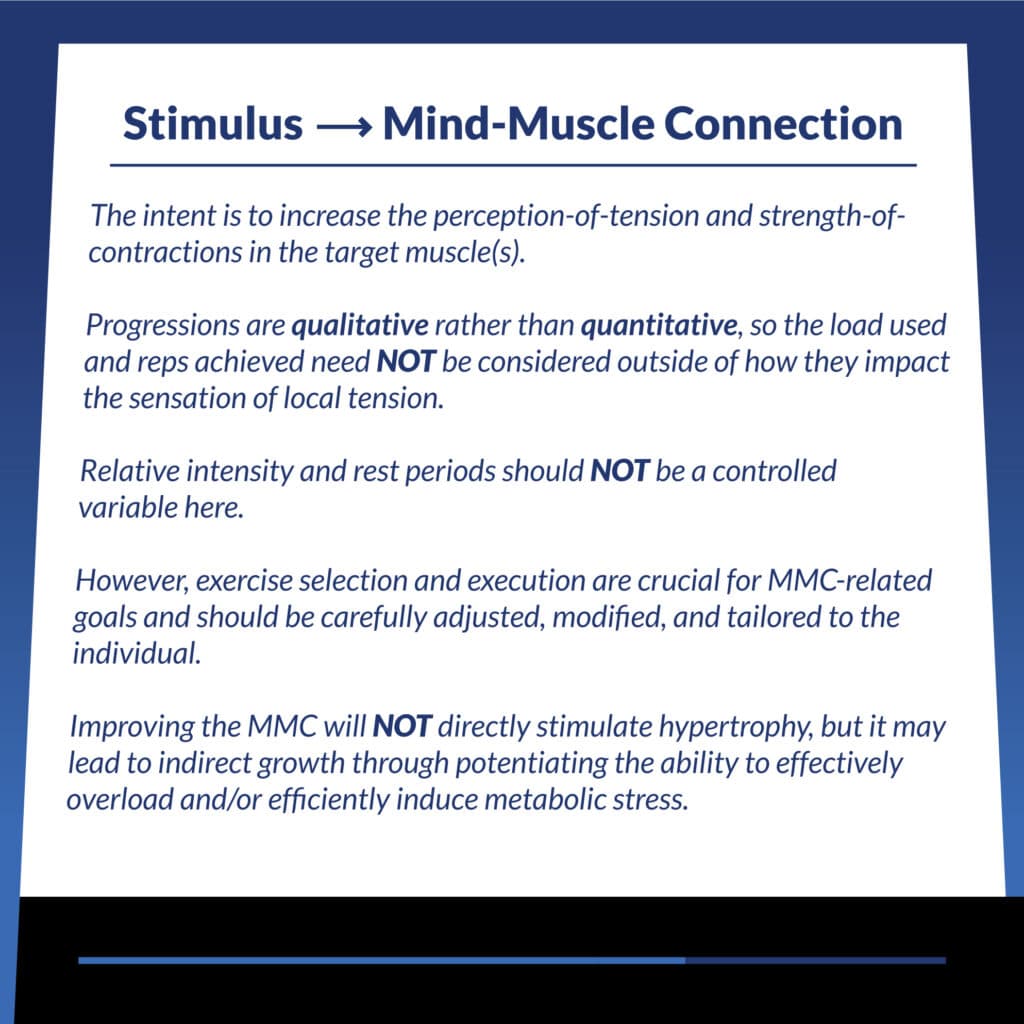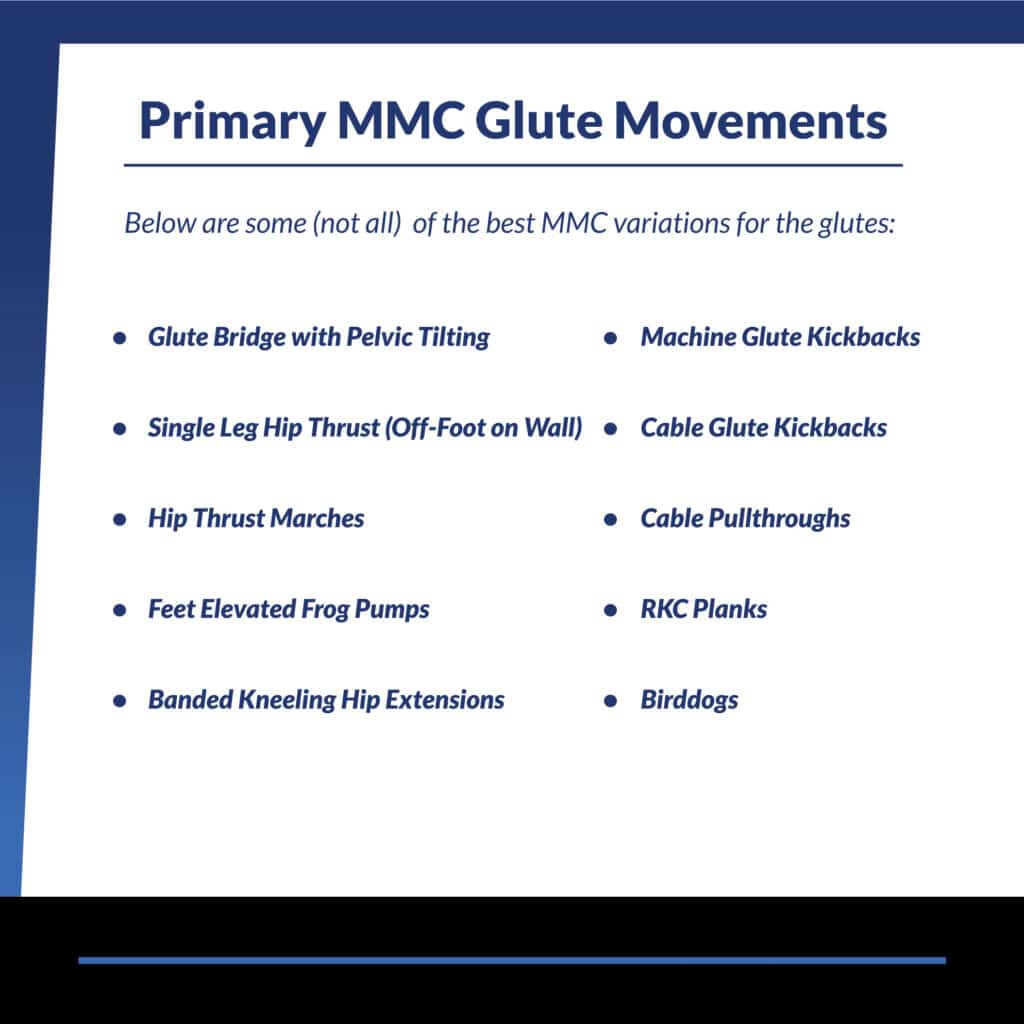Mind-Muscle Connection (MMC): The intent is to increase the perception of tension and strength of contractions in the target muscle(s). Progressions are qualitative rather than quantitative, so the load used and reps achieved shouldn’t be considered outside of how they impact the sensation of local tension. Relative intensity and rest periods should NOT be a controlled variable here. However, the variations used have the highest importance for MMC-related goals, comparatively, and should be carefully tailored to the individual. Improving the contractile ability/strength of a muscle will NOT directly stimulate hypertrophy, but it may lead to indirect growth through potentiating the ability to effectively overload and/or efficiently induce metabolic stress.
I don’t think it’s a stretch to say that the MMC, and how it relates to glute growth, is probably the most misunderstood and misapplied concept in all of hypertrophy training. Without getting too into the weeds (for a deep dive, make sure to check out my article Of Snipers and Rocket Launchers), we can confidently state that growing the glutes has much more to do with consistent progressive overload than it does being able to feel the glutes working at all times. Adding volume load with resilient technique can brute-force hypertrophy in a way that no manner of squeezing and contracting can match in magnitude of stimuli.
Having said that, there are contexts in which deliberate squeezing and contracting—in lieu of overloading—can actually be a better use of time, volume, and energy. Because the glutes are at the epicenter of many of the body’s most-complex and load-bearing patterns, it can be challenging to isolate and effectively-tax them. Going heavier and achieving more reps on heavy hinge and squat patterns is a great way to make progress, but this method begins to lose some efficacy if the glutes’ strength of contraction cannot keep up with the rising intensities. Along similar lines, the continuous barrage of progressive overload can easily distract from the gradual regression in qualitative markers (i.e. how well the target muscle is actually being stimulated). It can be useful to implement specific movements, at specific times, that serve to “fan the flame” of glute activation in order to potentiate the effectiveness of PO and MS work.
The lowest level of glute MMC work is pelvic-tilting drills that reinforce proper positioning and neutrality. These types of movements can be performed as prehab or extended warm-ups, and with high volumes. Pelvic-tilting done correctly allows the glutes to work within their strongest positions, and has the second-order effect of protecting the low back against injury. Perfecting this ability/pattern is an absolute requirement for getting the most out of glute training, even if they aren’t what would typically be thought of as MMC work.
One level above pelvic-tilting is being able to sustain tension in the glutes throughout varying fiber lengths. Utilization of specific and targeted variations like kickbacks, pullthroughs, and frog pumps can be a great way to solidify the brain-to-muscle neural strength, which can then be carried over to movements like RDLs, Hip Thrusts, and Split Squats that have a greater magnitude of stimulus but also more limitations. Exercises designed to improve the MMC will have to be extremely specific to the trainee—variations should be adjusted, modified, and substitutes ad libitum in order to find those that induce the strongest perception of tension.
I recommend doing the majority (if not all) of the MMC-specific work at the beginning of a given training session. This is meant to get the brain and glutes “on-line” without creating fatigue. With that being said, the volume of this work should be done at the absolute lowest effective dose, and the intensity/load should NOT be a factor. Do not stress the rep ranges either, although tempos (for dynamic exercises) can be your best friend here. Unilateral variations will typically allow for much stronger MMC when compared to bilateral counterparts, but it’s equally (if not more) important to be able to integrate MMC with each side simultaneously.
There doesn’t have to be any MMC-specific work in your glute sessions if time and/or energy are limited, or if glute contractile strength isn’t a hindrance to effective training.
Below are some of the best MMC variations for the glutes:
Glute Bridge with Pelvic Tilting
Single Leg Hip Thrust—Off-Foot on Wall
Banded Kneeling Hip Extensions
*Note: Not everyone will respond in the same way to the same specific exercises, or even movement patterns. For that reason, it’s crucial to experiment with different variations, modalities and execution variables in order to find those that best suite your individual anatomy, strengths and limitations. Keep track of objective data and subjective biofeedback in order to make unbiased exercises selections.



